|
FAQs on Carbon Dioxide and Planted
Tanks 2
Related Articles: Carbon dioxide and the planted freshwater
aquarium by Neale Monks, CO2 Canopies,
Related FAQs: CO2
& Planted Tanks 1, CO2 Canopies, & FAQs on CO2 Planted Tanks: Rationale/Use, Sources, Yeast-Bottle Types, Compressed Gas Types, Control/Delivery, Measure, Dangers,
|
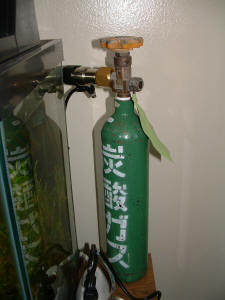
|
CO2 FW set up question /RMF
8/31/16
Greetings,
<Salud>
I am setting up a freshwater planted tank, 120 gallons with CO2. CO2
includes tank, regulator, needle valve, bubble counter and reactor (DIY
with maxi-jet, recirculating to venturi on pump). Lighting will be
something along the lines of Finnex Planted + 24/7 fixtures.
I also will have it set up to a left over Digital Aquatics controller
with Ph probe.
Is it better to use the controller/Ph probe (which, yes, will be
calibrated before starting up) and run the CO2 dosing off a set Ph level
(probably something in low 7s), or run the CO2 based off the lighting
timer?
<I'd run the pH monitor AND a timer on it... operating/adding
the CO2 during "lights on" hours or inside of these hours. Running CO2
when the lights are off can be tricky to deadly; driving pH down if
buffering is off>
I haven't decided on plantings, but I have tended to lean towards
medium/low light plants. I was hoping with the CO2 and sufficient
lighting to maybe branch (pun intended) into some higher intensity
plants.
Thanks for the help.
P.B in S.D.
<Oh, BobF in San Diego.... Will ask NealeM to resp. separately>
re: CO2 FW set up question 8/31/16
Unfortunately, running the solenoid off both timer and ph controller
isn't an option. Sounds like running off light period and keeping an eye
on PH is probably way to go?
<On during lights on then. BobF>
CO2 FW set up question /Neale
8/31/16
Greetings,
<Hello Paul,>
I am setting up a freshwater planted tank, 120 gallons with CO2. CO2
includes tank, regulator, needle valve, bubble counter and reactor (DIY
with maxi-jet, recirculating to venturi on pump). Lighting will be
something along the lines of Finnex Planted + 24/7 fixtures.
I also will have it set up to a left over Digital Aquatics controller
with Ph probe.
Is it better to use the controller/Ph probe (which, yes, will be
calibrated before starting up) and run the CO2 dosing off a set Ph level
(probably something in low 7s), or run the CO2 based off the lighting
timer?
<I would say using the pH probe. If the pH isn't right, fish can
die; if the CO2 doesn't match light intensity, you just have less the
perfect plant growth. Because pH changes as photosynthesis rate changes,
pH and light intensity should track each other. Specifically,
when plants do more photosynthesis (because there's more light) the pH
goes up as dissolved CO2 (an acid) is removed from the water. Your pH
meter should detect that and add extra CO2 as required.>
I haven't decided on plantings, but I have tended to lean towards
medium/low light plants.
<In which case CO2 might not be needed. Overdoing CO2 when the plants
aren't growing fast enough can cause a variety of problems. CO2 isn't
needed at all for low-light (= slow growing) plants such as Anubias,
Java ferns and Java moss.>
I was hoping with the CO2 and sufficient lighting to maybe branch (pun
intended) into some higher intensity plants.
<Understood. Just ramming in a few high light intensity plants into a
tank with low light plants doesn't always work though. Things like
Anubias tend to get covered with algae unless positioned in relatively
deep shade, and fast-growing plants will overwhelm slower growing plants
if positioned in brightly lit areas. Some careful planning will be
required here! There are various plant-specific forums on the web, such
as ukaps.org, and I'd run your ideas past those folks before spending
too much money or time on your project.>
Thanks for the help.
P.B in S.D.
<Welcome, Neale.>
dIy C02 SYSTEM 12/10/13
Hello wwm crew,
I am considering setting up a minor diy co2 system for my 125
gallon Planted tank.
<Mmm, one this size... and for what's invested, can be done... I'd go
with a commercial rig>
The plants are currently anubias, Lots of Giant Val, java fern, java
moss and an onion plant(generic name as the real one escapes
me).
<Likely Crinum>
Current stock is a 10 inch jack Dempsey, 2 Senegal bichirs, 12 giant
Danios, 2 BN Plecs.
Filtration is 2 55/75 Aqueon power filters that documentation claims
move 400g an hour. ( I realize that's at optimum performance). one on
each end of the 6 ft tank. I also use flourish tabs
approximately 5 tablets a month stuck by the base of the plant clusters.
The tanks get 12-13 hours of light a day.
I do not want anything to crazy in the co2 system was going to
put a single two liter with a sugar and yeast mixture at each end
of the tank with the hose placed in the intake of that ends filter.
My plants already grow ok just a little slower than I would
like. I want the Val to spread faster as the bichirs love to weave
through it and the more plants there are the Dempsey's plant tearing
gets spread out more) I figured some co2 is better than none and may
speed up growth. (also Have a minor algae problem on my rocks I was
hoping this would help alleviate...only on my slate not on the glass at
all)
<Okay>
My concern is that my tank does have a fair bit of surface movement from
the two filters ( I do not want to loose
<lose?>
this as it seems to be the primary entertainment of my Danios. they take
turns forcing each other out of the current then swimming in it).
Also that my filters are self priming so if I feed the hose from the co2
into my intake it may proceed too siphon out the yeast mixtures.
I have also read about DiY systems nuking the oxygen out of tanks at
night which worries me a bit.
any advice or suggestion on this would be appreciated.
<Not to worry... Hopefully the sort, size generator, delivery system
will grant you some positive, appreciable plant growth... It is
very doubtful it can/will cause trouble. Bob Fenner>
Re: dIy C02 SYSTEM 12/10/13
I was worried about losing the current from the filters if I had to put
in a diffuser to knock down surface agitation in order to not lose co2.
<Ehh! Some of this, some of that>
My understanding is that surface agitation oxygenates the water and
releases the c02.
<To some degree>
With me adding as little as I am I was worried the diffuser would be a
necessity to not loose what little co2 I am trying to add.
thank you for the quick response.
<Welcome. BobF>
Planted tank filtration/co2 equilibrium?
4/14/2011
Hello WWM crew!
<Hello,>
Hope you guys/gals are doing great and all is going well. As for
myself, I'm in search of a new adventure, in aquaria of course,
which brings me back to writing to you for a few quick answers if you
could.
<Sure.>
I am planning on setting up a 55 gal. moderately planted tank with no
co2. I have tried a couple plants here and there with my fish tanks
over the years and they never seems to work out, even the so stated low
light, low maintenance, hardy plants. This time, after viewing through
many Amano tanks, got my blood pumping once again'¦
<Oh noes!>
The setup will consist of: 55 gal. tank, T5HO 216 watts light (three
6500k bulbs and one 650nM bulb), approximately 3 inch layer of
eco-complete, a Marineland Emperor 400 HOB filter, and a small in-tank
powerhead with an attached sponge/ceramic noodle canister. So far so
good?
<Sure. But do of course remember that the more splashing, the more
CO2 is driven off. That's why HOB filters aren't a good choice
for these sorts of tanks, though they have been used successfully, I
have no doubt.>
My question is, from research, it seems that as though the HOB filter
is a bad idea, due to surface agitation driving off the limited supply
of co2 in the water.
<Yes.>
Now reading at various info sources, this is true in the case of a co2
injected tank, but with a non injected tank, surface agitation is
desirable?
<Don't see the logic here. The agitation at the surface
increases the surface area of the water, and therefore CO2 will diffuse
from the site of high concentration (the water) to low concentration
(the air). Whenever you add CO2 to the tank, what you're doing is
trying to exceed that diffusion rate by some carefully controlled
amount, so an optimal CO2 concentration is maintained in the water. In
almost all cases, plain vanilla aquaria have less CO2 in the water than
is optimal, so plant growth can be limited by that -- assuming other
factors, particularly light, are optimal. Nonetheless, light is FAR
more often the limiting factor holding back plant growth in aquaria,
not CO2, which is why most people find improving light increases their
success with plants, whereas adding CO2 is the "icing on the
cake" once you've already optimised lighting.>
Reason being is that the limited supply of co2 in the tank will be
consumed rather quickly by the plants, and just like oxygen, co2 from
the atmosphere will be infused into the water, though at low amounts,
until an equilibrium is reached?
<There certainly is diffusion of CO2 between air and water, though
the direction will depend upon which contains the most. But diffusion
will have hardly any impact at all below the top millimetre, if that.
Below that depth, it's circulation of water around the tank by your
pumps that keeps CO2 moving around. Yes, if your plants are
photosynthesising fast they will pull the concentration of CO2 in the
water down towards zero, and yes, that'll cause diffusion of CO2
from the air into the water. But the rate that happens is slow, and in
practical terms, plant growth will usually be held back through lack of
CO2 because the supply of CO2 from the air via diffusion just isn't
fast enough. Hence adding CO2 to aquaria where very fast plant growth
rates are desired.>
Is this true and should it be followed? Basically circulation and
surface agitation desirable in a non co2 injected planted tank?
<Agitation is, broadly, undesirable, at least if you want to
minimise the cost of adding CO2. Of course if you can supply CO2 faster
than agitation allows it to diffuse out into the air, then that
isn't a problem.>
Or should I be looking for an external canister filter where I can put
the return underneath the water line?
<This is the standard approach.>
I doubt it will turn into an Amano creation, but we'll see where it
leads me... Tank will be mostly plants with very little live stock, but
I refuse to have a tank without a Pleco of some sort.. Love those
catfishes and was thinking of an Ancistrus of some sort for this
tank.
<Can work in planted tanks. But do look at things like Parotocinclus
jumbo and Hypancistrus sp. L260 as potential alternatives. Obviously
the more carnivorous genera, such as Hypancistrus, are better bets than
the more dedicated herbivores, such as Panaque.>
Thanks greatly for your time and effort. Hope everybody has a great
year!
<And today is, in fact, Khmer New Year, I'm told.>
Andy
<Cheers, Neale.>
|
Large Planted Tank with CO2 9/19/10
Hello,
I have started a 150 gallon planted freshwater tank and have a
previous CO2 system I would like to add. My dilemma is 1) how do
I measure how much CO2 I need for such a large tank? 2) I have a
small ceramic glass diffuser from ADA that is about 1"
diameter. It says it is for up to 20 gallons which is too small
for my tank. What do I need to use as a diffuser for such a large
size tank? I have upgraded to a used 0.6 kg CO2 tank (please see
picture) and had it modified to attach to a simple CO2 system
bought in a local pet store. I have a glass bubble counter to
suction to the outside of the tank and a glass CO2 reader which
shows yellow, green, or blue depending on how much is in the
water. Should I just put the diffuser in there under the output
tubes and see what the CO2 reader says in a day or two? I have
attached pics of when It was hooked up to my 20 gallon quarantine
tank I was using for plants. I have invested too much money in
this already and am not really looking to add to it if I
don't absolutely have to. Is there any way I can use this
system in my large tank?
Thank you all!
Lisa
<Lisa, having seen photos of your tank, I'm almost 100%
sure that CO2 will make no difference at all. Can I strongly urge
you to focus on [a] light intensity and [b] choosing the right
plants for your ambient lighting levels, water chemistry, water
temperature, and water current. I have an article about all of
this coming in the next WWM Digital magazine which should be up
in the next week. But in brief, there are two ways to decide how
much CO2 to add. The first is trial-and-error. Assuming intense
lighting, if you add CO2 at the tiniest amount you can in
bubbles/second and wait for an hour, you should see
"pearling" of oxygen bubbles on some plants. If not,
add a tiny bit more. Repeat as required, all the time checking
that [a] the fish don't look stressed and [b] there isn't
a wild pH swing (there will be a slight pH decrease as you add
CO2, but if it goes from 8 to 6 that's too much!). This
approach is hit-and-miss and not terribly safe. The better
approach is to use a CO2 test kit to measure the dissolved CO2.
This should be between 10 and 20 mg/l. Add sufficient CO2 for a
concentration of 10 mg/l, wait a couple of weeks, and if plant
growth still isn't as good as you'd like, increase to 15
mg/l, and then a couple weeks later to 20 mg/l if needs be.
Again, make sure the fish stay happy.
Above 25 mg/l CO2 will quickly kill your fish; in fact using CO2
is quite a good way to euthanise fish! So be very careful. There
is a relationship between pH and CO2 concentration assuming you
know the carbonate (not general!) hardness, so you can use a pH
test kit to measure CO2 concentration. The formula is 3 x
carbonate hardness (in degrees KH) x10(7-pH); thus if carbonate
hardness is 5 degrees KH and the pH is 7.6, then the amount of
carbon dioxide in the water will be 3.78 mg/l. If you're
maths-phobic, then using a CO2 test kit will be safer. With all
this said, your aquarium doesn't have enough lighting for CO2
to make much difference either way. You'd get far better
results concentrating on plants adapted to relatively low light
levels. These will find the CO2 produced by your fish and the
filter more than enough, and even more so if you added a proper
substrate, since microbes in the gravel and sand produce CO2 as
well. Anubias, Java fern, Cryptocoryne wendtii, Vallisneria
spiralis, hybrid Aponogeton, floating Indian fern, Amazon Frogbit
-- all these should do fine in an aquarium with 1-2 watts/gallon,
without the need for CO2. There is a VERY COMMON misconception in
the hobby that CO2 is the thing that makes or breaks plant growth
in aquaria. To some degree, the people selling CO2 appliances
foster this idea. But it is COMPLETELY WRONG. While CO2 can make
good planted tanks even better, it won't turn around a poor
or mediocre one. It's a bolt-on goody for already successful
systems. Cheers, Neale.>
|
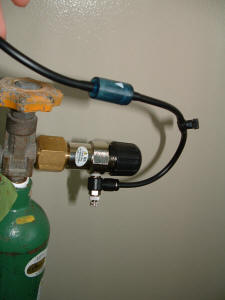 
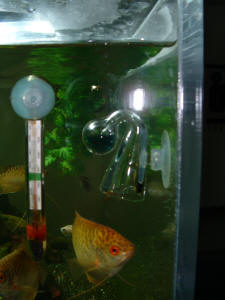 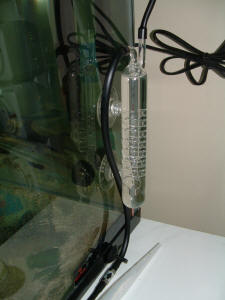  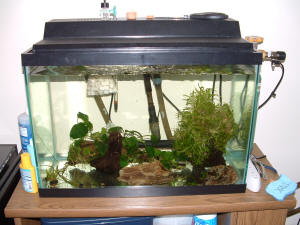 |
water chemistry, FW... as relates to fish lvstk. sel. and
planted system CO2 maint. 7/6/10
Dear Crew,
Thank you for the assistance that you provide us fellow hobbyists.
<Kind of you to say so.>
My question is related to water chemistry. I am currently in the
process of setting up a 29 gallon freshwater planted tank. I have
tested my tap water in the hope of determining the most appropriate
water for various moderate to high light plants for my community tank.
The tank will probably house Nerite snails, cherry shrimp, a couple
Otocinclus and a school of tetras, probably Rummynose or cardinals
though I understand cardinals don't like a lot of light ( 2 62 watt
T5HO's).
<Okay. Well, for this mix you're after soft water. Cardinals
require warmer water than Otocinclus, so they're poor companions.
Yes, Cardinals are "photophobic" which is why they always
look so terrified in Amano-style tanks! Fish school tightly when
scared, and if you've ever seen a photo of an aquarium where the
tetras are all bunched up, it's because they're frightened. One
of the reasons I'm not a huge Amano fan is precisely this, that the
need to create an aquarium that looks good in photographs trumps the
needs of the fish. Stream-dwelling fish like Danios would be better for
a tank like yours. Danios do well in the cooler conditions Otocinclus
and Cherry shrimps desire, and don't mind open water at all. You
aren't limited to Zebra Danios by any means, and with a bit of
effort you should be able to find Glowlight Danios, Leopard Danios,
Pearl Danios, and others. Minnows might work well too, both White Cloud
Mountain Minnows and Vietnamese Cardinal Minnows are brightly coloured
and thrive in relatively cool, bright conditions.>
My question is in regard to my tap water. I live in Arizona and my home
has a water filter in the garage that is attached to all water coming
into the house. The only thing that I know about this filtration system
is that it has a prefilter and the water is filtered through carbon. I
used API test kit for KH and GH. The tap water measures 6 drops for KH
and I stopped trying after 30 drops for GH.
<Liquid rock. Perfect for livebearers; terrible for tetras. Your
Cardinals would be dead within a year, likely 6 months, in such
conditions.>
I then mixed the tap water 50/50 with RO water purchased from the local
Wal-Mart Culligan system and the mix resulted in GH 14 and KH 4.
<This is moderately hard water; too hard for Cardinals in the long
term, but fine for Danios and Livebearers, as well as the hardier Barbs
and most Rainbowfish.>
I am afraid to use this mix as I was planning on using CO2 DIY and
don't want the pH to crash due to the unstable KH of the mixed
water.
<You will have to dose the CO2 carefully depending on the carbonate
hardness. If you don't understand the relationship between pH, KH
and the required CO2 concentration -- READ before even thinking about
proceeding.
Please start here, with our friends over at The Krib:
http://www.thekrib.com/Plants/CO2/
I cannot stress too strongly how much easier CO2 is if you use a semi-
or fully-automatic dosing system.>
Please advise my on how this carbon filtration has affected my tap
water
<Filtering through carbon has no real impact on water chemistry at
all; it removes some toxins, but that's about it.>
and if you think it would be wise to use straight tap with such a high
level of GH and low level of KH.
<If you choose hard water fish like Guppies, sure. There are
numerous plants that love hard water, and these usually don't need
CO2 since they use bicarbonate in the hardness as their carbon source.
Vallisneria and Elodea are two classic examples.>
The pH of the tap measured 7.4 and was the same with the 50/50 mix.
Thank you,
Suz
<Cheers, Neale.>
|
|

